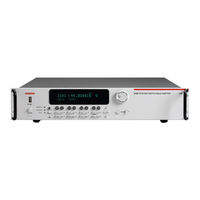Keithley 3700 series Manuals
Manuals and User Guides for Keithley 3700 series. We have 5 Keithley 3700 series manuals available for free PDF download: Reference Manual, User Manual, Installation Instructions Manual
Keithley 3700 series Reference Manual (657 pages)
System Switch/Multimeter
Brand: Keithley
|
Category: Test Equipment
|
Size: 7 MB
Table of Contents
-
Overview23
-
Introduction23
-
Introduction27
-
Queries29
-
Scripts30
-
GPIB Address38
-
User Scripts42
-
Remote State58
-
Local State58
-
Introduction59
-
Operators60
-
Functions61
-
Precedence63
-
Branching66
-
Loop Control67
-
Introduction73
-
Display92
-
CONFIG Key99
-
DISPLAY Key104
-
POWER Switch105
-
RESET Switch105
-
Operation Keys105
-
CHAN Key105
-
DELETE Key108
-
DMM Key109
-
ENTER Key113
-
EXIT Key113
-
FILTER Key113
-
Function Key114
-
INSERT Key114
-
LIMIT Key115
-
LOAD Key115
-
MENU Key116
-
PATT Key117
-
REL Key118
-
RUN Key118
-
SCAN Key119
-
SLOT Key120
-
TRIG Key120
-
AUTO Key120
-
CURSOR Keys120
-
Navigation Wheel121
-
RANGE Keys121
-
Action Keys121
-
CLOSE Key121
-
OPEN ALL Key121
-
OPEN Key122
-
RATE Key122
-
Recall Key122
-
STEP Key122
-
STORE Key123
-
Range125
-
In this Section125
-
Scanning127
-
Scanning128
-
Setting Digits128
-
Rate129
-
Bandwidth131
-
Filter132
-
Relative137
-
Scanning139
-
MX+B140
-
Percent142
-
Reciprocal (1/X)143
-
Db Commands146
-
Db Configuration146
-
Db Scanning147
-
Buffer Overview149
-
Storing Readings151
-
Saving Readings151
-
Time Stamp153
-
Channel Display154
-
Reading Buffers160
-
Buffer Status164
-
In this Section173
-
Scanning173
-
Events174
-
Event Blenders175
-
Trigger Model176
-
Buffer181
-
ICL Commands184
-
In Slot 3190
-
In this Section203
-
File Formats203
-
Files203
-
File I/O205
-
Script Examples206
-
In this Section217
-
Overview217
-
TSP-Net217
-
Example Script219
-
In this Section231
-
LXI Event Log237
-
Status Model241
-
Queues242
-
Queues265
-
Output Queue265
-
Error Queue266
-
In this Section267
-
Wild Characters267
-
Syntax Rules270
-
TSP-Linktm Nodes271
-
Query Commands272
-
ICL Command List277
-
Bit Functions283
-
Delay Functions352
-
Exit Functions446
-
File Functions447
-
Fs Functions452
-
Gpib Attributes453
-
Io Functions454
-
Memory Functions485
-
Opc Functions486
-
Print Functions487
-
Reset Functions496
-
Timer Functions552
Advertisement
Keithley 3700 series Reference Manual (434 pages)
System Switch/Multimeter
Table of Contents
-
Introduction17
-
Introduction
18 -
-
Queries22
-
Scripts23
-
User Scripts33
-
-
Remote State42
-
-
-
Introduction43
-
Operators44
-
Functions45
-
Precedence47
-
Branching49
-
Loop Control50
-
-
-
Display59
-
-
-
Relative87
-
Math89
-
Db Commands93
-
Db Scanning94
-
-
-
Scanning
109-
-
SCAN Operation116
-
STEP Operation117
-
-
ICL Commands118
-
Examples120
-
-
Status Model
123-
Queues142
-
Output Queue142
-
Error Queue142
-
-
-
-
Wild Characters145
-
TSP-Link Nodes148
-
Query Commands149
-
-
Bit Functions153
-
Delay Function192
-
DMM Functions213
-
Exit Function271
-
Gpib Attribute274
-
ICL LAN Commands276
-
-
Localnode.define292
-
-
Opc Function299
-
Printbuffer299
-
Reset Function300
-
Scan Functions301
-
Timer Functions352
-
Trigger.timer353
-
Tsplink.trigger356
-
-
Trigger.blender360
-
-
Upgrade365
-
Keithley 3700 series User Manual (292 pages)
Table of Contents
-
Introduction22
-
Overview22
-
Display29
-
CONFIG Key35
-
DISPLAY Key40
-
POWER Switch41
-
RESET Switch41
-
CHAN Key41
-
DELETE Key44
-
DMM Key44
-
ENTER Key48
-
EXIT Key49
-
FILTER Key49
-
Function Key50
-
INSERT Key50
-
LIMIT Key51
-
LOAD Key51
-
MENU Key52
-
PATT Key53
-
REL Key54
-
RUN Key54
-
SCAN Key55
-
SLOT Key56
-
TRIG Key56
-
AUTO Key56
-
CURSOR Keys56
-
RANGE Keys57
-
Action Keys57
-
CLOSE Key57
-
OPEN ALL Key57
-
OPEN Key58
-
RATE Key58
-
Recall Key58
-
STEP Key58
-
STORE Key59
-
Rear Panel60
-
Slots61
-
Connections69
-
Pseudocards70
-
Power-Up73
-
Overview76
-
Warm up102
-
Autozero102
-
Connections107
-
Schematic110
-
Auto Delay115
-
Measure Count118
-
Connections128
-
Thermocouples151
-
Thermistors160
-
Trigger Level169
-
Gate Time169
-
Temperature177
-
Temperature178
-
Digital I/O180
-
Analog Output188
-
Calibration195
-
Latching Values202
-
Maintenance206
-
Introduction206
-
Fuse Replacement206
-
Test Procedure208
-
Pseudocards218
-
Interlock Status220
Advertisement
Keithley 3700 series Installation Instructions Manual (14 pages)
cables and connector kits
Keithley 3700 series Installation Instructions Manual (11 pages)
Screw Terminal Assemblies
Brand: Keithley
|
Category: Touch terminals
|
Size: 1 MB




